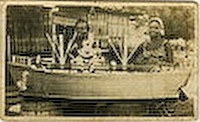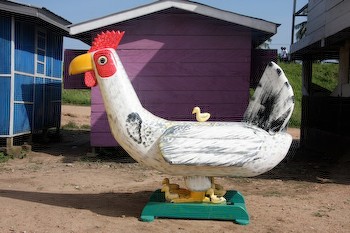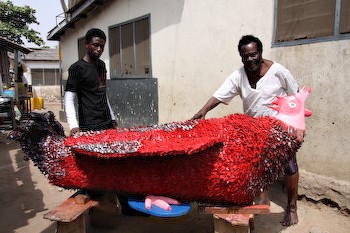|
 The
Kane Kwei Carpentry Workshop is a studio established in Teshie, Ghana, since
the Fifties. It is known for its Design Coffins that became symbolic of
African artistic creativity. The
Kane Kwei Carpentry Workshop is a studio established in Teshie, Ghana, since
the Fifties. It is known for its Design Coffins that became symbolic of
African artistic creativity.
Seth Kane Kwei ( 1922–1992 ) was a
carpenter joiner established in Teshie, in the suburbs of Accra in Ghana. He
is considered as the inventor at the beginning of 1950s of the design
coffins or fantasy coffins, called Abebuu adekai (" boxes with proverbs
") by Ga people that is the dominant ethnic group of the region of Accra.
The use of these coffins during the burial in Ga country became widespread
from the beginning 1960s, becoming de facto a real tradition. Design coffins
are acknowledged as symbolic of the contemporary creation in Africa.
  At the death of Kane
Kwei, his son Sowah took over the workshop, then Cedi - junior child of Kane
Kwei- after the death of Sowah in 1999. Since 2005, Eric Adjetey Anang (born
1985, son of Cedi) attempts to revitalize the creativity of the studio by
the introduction of new models, the creation of furniture realized in the
same spirit and with the same techniques as the coffins. At the death of Kane
Kwei, his son Sowah took over the workshop, then Cedi - junior child of Kane
Kwei- after the death of Sowah in 1999. Since 2005, Eric Adjetey Anang (born
1985, son of Cedi) attempts to revitalize the creativity of the studio by
the introduction of new models, the creation of furniture realized in the
same spirit and with the same techniques as the coffins.
About ten carpenter's workshops established in Teshie and in the region of
Accra produce similar coffins. Among them, we find Tei in Dorwanya, Lay and
Hello in Teshie, Tetteh in Amasaman and Tetteh Red in Ningo. Their bosses
are former apprentices of Kane Kwei or his successors. Furthermore there are
the workshops of Kudjoe Affutu and the master craftsmen Paa Joe and Paa
Willie in Nungua, both of them trained carpenters at Kane Kwei's, before
they opened their own shops.
The Kane Kwei workshop uses light wood
as wawa (white wood) or emien for the coffins intended for funerals. Those
dedicated to the export as artworks are made from harder and more expensive
wood as limba or African Mahogany.
The Kane Kwei workshop is profoundly anchored in the Ga tradition, both by
the genesis of its productions, by protocols framing their local use, and by
its kind of functioning based on apprentices, which number can reach about
ten. At the end of the apprenticeship which lasts from two to five years, a
traditional ceremony is organized. In this occasion, the apprentice has to
pay a sum of money, donate alcoholic drinks, a parasol, a pair of sandals to
the boss of the workshop and a certificate is put handed to him.
The manufacturing process of coffin begins by the scrupulous observation of
visual documents reproducing the considered model - even of the very model,
an alive hen for example - at once followed by its performance in three
dimensions. Neither plans nor sketches are realized in prerequisite to their
manufacturing.
If some units had been acquired in the 70s by some American gallery owners
(Vivian Burns in 1973, Ernie Wolfe, both from Los Angeles) it is from 1989
when these objects reached an international gratitude recognition as oeuvres
of art.
 Their successive
displays in the exhibitions Magiciens de la terre (1989, Musée National
d'Art Moderne (Centre Georges Pompidou), Paris and Grande Halle de la
Villette, Paris - Curator Jean-Hubert Martin) and "Africa Explores" (1992,
New Museum of Modern Art, New York - Curator Susan Vogel) were release
mechanisms of this recognition. On the initiative of the Studio, artistic
partnerships with western structures were implemented and residences of
foreign artists organized. Their successive
displays in the exhibitions Magiciens de la terre (1989, Musée National
d'Art Moderne (Centre Georges Pompidou), Paris and Grande Halle de la
Villette, Paris - Curator Jean-Hubert Martin) and "Africa Explores" (1992,
New Museum of Modern Art, New York - Curator Susan Vogel) were release
mechanisms of this recognition. On the initiative of the Studio, artistic
partnerships with western structures were implemented and residences of
foreign artists organized.
Coffins created by Kane Kwei
Carpentry Workshop - not exhaustive list
|
Type |
Subject |
|
Animals |
Eagle• Antelope • Whale • Cameleon • Dove •
Coq • Crab • Turkey • Crayfish • Elephant •
Snail • Lobster • Lion • Peacok • Parrot •
Red fish • Striped fish • Catfish • tilapia
• Pig • Hen • Shark • Sardine • Snake • Tuna
• Turtle • Cow • Aulacode (Thryonomys
swinderianus) |
|
Buildings |
Church • House |
|
Fruits and vegetables |
Pineapple• Banana • Cocoa pod • Sugar cane •
Corn • Palm nut • Onion• Red pepper • Green
pepper • Pumpkin |
|
Objects |
Soccer ball • Bible • Bottle of Star beer •
Bottle of Coca Cola • Can of Aquarius energy
drink • Soccer shoe • Spaner • Traditional
sword • Hunting gun • Machine gun • Guitar •
“Graphic” newspaper • Fishing net • Spoon •
Sewing machine • Pot • Hammer • Microphone •
Outboard engine • Piano • Cinema projector •
Plane • Robot • Flour bag • Chief's scepter
• Saw • Seringe • Referee whistle • Smith's
bellows • Ballpoint with notebook • Asante
stool • Bass drum • Talking drum • Mobile
phone • Trowel |
|
Vehicles |
Ambulance • 32 seats bus • Aircraft (Ghana
Airways) • Aircraft (KLM) • Cruise ship •
Bedford truck • Garbage truck • Fire truck •
Fishing boat • War tank • Volkswagen minibus
• Tractor • Mercedes-Benz car • Toyota
Corolla |
|
Others |
Sun |
|
Group exhibitions
- 2005 "Arts
of Africa“, Grimaldi Forum, Monaco, France
- 2005
"African Art Now”, Museum of Fine Art, Houston, USA
- 2005 "Sexualität
und Tod - AIDS in der Zeitgenössischen Afrikanischen
Kunst", RJM Museum, Cologne, Germany.
- 2003 "Ghana:
hier et aujourd’hui=Ghana: Yesterday and today",
Musée Dapper, Paris, France
- 1998 "AFRICA
Vibrant New Art from a Dynamic Continent”, Tobu
Museum of Art, Tokyo, Japan.
- 1996 "Neue
Kunst aus Afrika“, Haus der Kulturen der Welt,
Berlin, Germany.
- 1993 "Skizzen
eines Projektes“, Ludwig Forum für internationale
Kunst, Aachen, Germany.
- 1991 "Africa
Explores: 20th Century African Art”, New Museum of
Contemporary Art, New York, USA.
- 1989 "Magiciens
de la Terre”, National Museum of Contemporary Art -
Georges Pompidou Center, La Grande Halle de la
Villette, Paris, France.
Solo exhibitions
- 2000 "Ein
Fisch für die letzte Ruhe“, Museum auf dem
Ohlsdorfer Friedhof, Hamburg, Germany.
- 1998 "Kane
Kwei”, Museum of Contemporary and Modern Art,
Geneva, Switzerland.
- 1997 "Wie
das Leben, so der Sarg...Nam June Paik“, Ifa
Gallery, Bonn, Germany.
|

 Their successive
displays in the exhibitions Magiciens de la terre (1989, Musée National
d'Art Moderne (Centre Georges Pompidou), Paris and Grande Halle de la
Villette, Paris - Curator Jean-Hubert Martin) and "Africa Explores" (1992,
New Museum of Modern Art, New York - Curator Susan Vogel) were release
mechanisms of this recognition. On the initiative of the Studio, artistic
partnerships with western structures were implemented and residences of
foreign artists organized.
Their successive
displays in the exhibitions Magiciens de la terre (1989, Musée National
d'Art Moderne (Centre Georges Pompidou), Paris and Grande Halle de la
Villette, Paris - Curator Jean-Hubert Martin) and "Africa Explores" (1992,
New Museum of Modern Art, New York - Curator Susan Vogel) were release
mechanisms of this recognition. On the initiative of the Studio, artistic
partnerships with western structures were implemented and residences of
foreign artists organized.